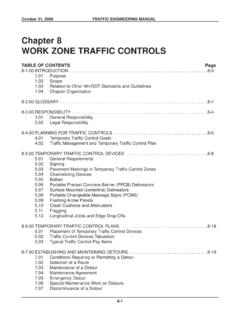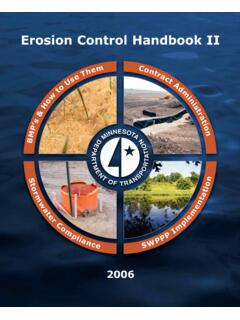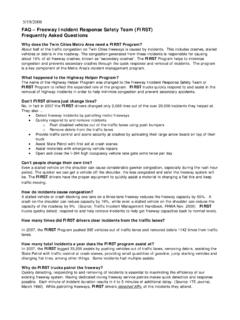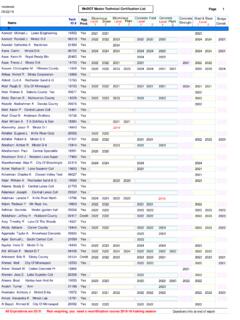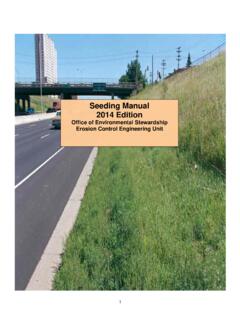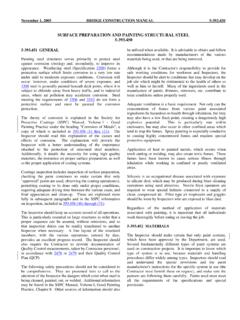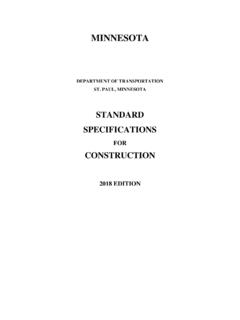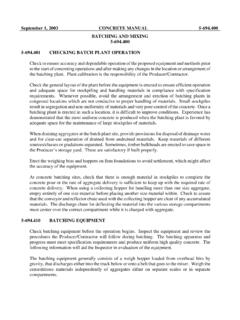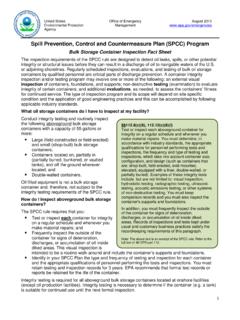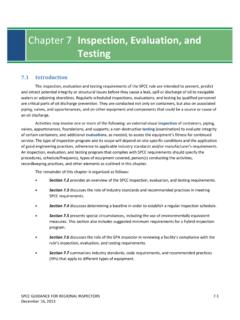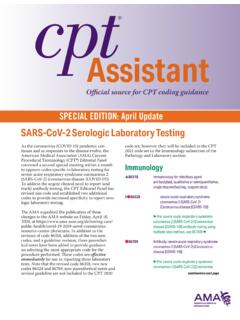Transcription of CONCRETE MATERIALS AND TESTING
1 September 1, 2003 CONCRETE MANUAL CONCRETE MATERIALS AND TESTING GENERAL REQUIREMENTS The Specifications contain requirements for all CONCRETE MATERIALS . Inspect all MATERIALS used in the construction of CONCRETE work at their source, on the job, or both. The Engineers and Inspectors must inspect all MATERIALS to assure they meet all requirements prior to incorporation into the work. Attention is called to Mn/DOT Standard Specifications for Construction References 1601 through 1607 and the sections of Division III (3000 Series) for the MATERIALS used. CEMENTITIOUS MATERIALS Cementitious material includes: portland cement, blended cements, ground granulated blast furnace slag, fly ash, silica fume, metakaolins and other MATERIALS having cementitious properties.
2 Only portland cement, blended portland cement, ground granulated blast furnace slag, and fly ash are addressed in this section. Cementitious material composed of portland cement, blended cements, ground granulated blast furnace slag, and fly ash are acceptable providing the material complies with 3101, 3102, 3103, 3115 and the substitution limits of Only certified cementitious sources are allowed. Do not use material of questionable quality (old, contaminated, wet, etc.) until approval is received from the Mn/DOT Office of MATERIALS Laboratory. Specification 1601 prohibits using more than one source of material without permission from the Engineer. It is generally preferable that for finished surfaces, such as bridge decks, walks and medians, as well as for retaining walls, a single brand is used throughout if possible.
3 For portions of a structure below grade, limitations on brands for control are not necessary. A list of certified cementitious material sources are available on the Mn/DOT CONCRETE Engineering website at A. Portland Cement Portland cement is made from four basic compounds, tricalcium silicate (C3S), dicalcium silicate (C2S), tricalcium aluminate (C3A), and tetracalcium aluminoferrite (C4AF). The cements used in Minnesota are made either from limestone and clay, limestone and shale, or limestone and slag. The manufacturing process known as the dry process is the most widely used at present. This consists of grinding the individual raw MATERIALS and feeding at controlled amounts into a rotary kiln and burning until they fuse into small lumps or balls called clinkers.
4 In the wet process, a slurry of the blend is fed into the rotary kiln. The clinkers are cooled and then ground in two operations. Between the first and the final grind, a quantity of gypsum (usually 2 to 3% by mass (weight) of cement) is added to regulate the setting properties of the cement. September 1, 2003 CONCRETE MANUAL Cement companies make various other types of cement such as High-Early, Air-Entraining, White Portland, Low Heat, and Sulfate Resisting Cements on special order. These are not normally used in Agency work. B. Blended Cements These blended cements are composed of one of five classes of hydraulic cement for general and special applications, using slag, fly ash or other pozzolan with portland cement, or portland cement clinker with slag.
5 Ternary blends are not allowed without the approval of the Mn/DOT CONCRETE Engineer. C. Ground Granulated Blast Furnace Slag (GGBFS) In the blast furnace, magnetic iron ore (Fe3O4) and haematic iron ore (Fe2O3) are fed along with limestone into a high temperature chamber containing coke. Coke is partially oxidized to carbon monoxide, which reduces the ores to iron. The other product that floats over the molten iron due to its relative lightness is called slag. Slag is composed of calcium oxide (CaO), silica (SiO2) and alumina (Al203). Slag is pulverized into a fine powder called ground granulated blast furnace slag and is used in this form as a cementitious component of CONCRETE . D. Fly Ash Fly ash is the most widely used pozzolan in CONCRETE . It is a fine residue resembling cement that is a by-product of burning coal in an electric power generating plant.
6 Depending on the chemical consistency of the coal source, the material is identified as Class C (self-cementing) or Class F (non-cementing) fly ash. CEMENTITIOUS MATERIAL HANDLING The principal consideration in all operations involving the handling and sorting of cementitious material is to avoid damage or contamination of the product prior to its incorporation in the work. Store cementitious material indefinitely if it is kept dry. Cement is usually improved and made more stable by a period of storage immediately subsequent to its manufacture since this permits stabilization of the free lime present in the freshly ground material. Cementitious material is very susceptible to damage by contact with water or exposure to a moist atmosphere.
7 When stored under such conditions for even comparatively short periods, cement takes up moisture and hydrates, making it unfit for use. Paper bags are somewhat resistant to atmospheric moisture, but do not provide adequate protection for long periods of storage. Material stored in bulk is less damaged by atmospheric moisture because the ratio of exposed surface to volume is much smaller than in sacked product. It is very important that lumps are screened out before use. When bulk cementitious material is batched on the job by mass (weight), it is imperative that the specified amount is placed in each batch. This includes not only the accurate measurement, but also the prevention of loss of cementitious material during batching and in transit to the mixer.
8 September 1, 2003 CONCRETE MANUAL On paving projects, Specification requires cut-offs for all cementitious MATERIALS . Make sure all shipments are received with seals intact. Make arrangements with the Contractor to document shipments received when the Agency is not present. Make positive cementitious material cut-offs after the use of approximately 250 metric tons (500,000 pounds) and again prior to the use of 1000 metric tons (2 million pounds). Thereafter, a cementitious material cut-off is made at least every 1500 metric tons (3 million pounds) or once a week, whichever provides the longest time interval between cut-offs.
9 The cementitious material cut-off is made at any time during the day. In making the cut-off, the Agency must know the exact amount of cementitious MATERIALS delivered to the plant. This quantity is determined from the invoices as specified in An estimate of the amount of cementitious material used to date is made at the completion of the work each day and is determined from the amounts placed into the storage bins and silos, minus the amounts remaining in them. This estimate is compared with the total amount used based on the batch tickets. The data for cementitious material received, unloaded, and used each day is recorded on the Cement Record (Form 2157). See Figure A (1 3). If using sacked material, the Inspector should assure that the entire contents of the bags are placed in the batch.
10 Workers are often careless in this respect, and often leave several kilograms (pounds) in a bag. Workers should tie empty bags into bundles of 50 during each pour so that they may readily check the amount used. After counting the empty bags, remove them from the mixing site before the next pour begins. CEMENTITIOUS MATERIAL INSPECTION Give all cementitious material some form of visual inspection prior to use. For certified cementitious MATERIALS , inspection and TESTING at the source is required for compliance. See the Schedule of MATERIALS Control for appropriate TESTING rates for the project. Sampling occurs at the ready-mix or paving batch plant and is submitted to the Mn/DOT Office of MATERIALS Laboratory for TESTING .
